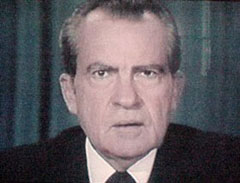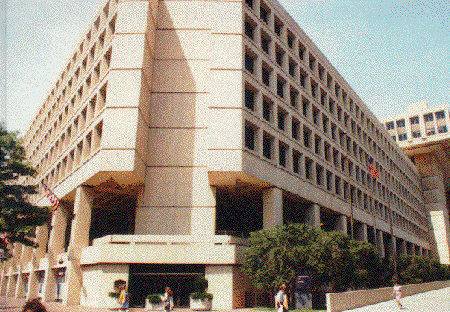|
● Racial Problems
● Poverty
● Drug Abuse
● Crime
● The Abuse of Power
by Government and Corporations
Crime
 |
|
President Nixon
|
 Crime
is one of the most serious social problems facing the nation. Former
President Nixon
remarked on several occasions that crime is the "number one
enemy" and that "we must declare war against it."
(Ironically, President Nixon and many of his top administrative
officials later faced criminal charges—with some being imprisoned—in connection with the Watergate
Affair.) Crime
is one of the most serious social problems facing the nation. Former
President Nixon
remarked on several occasions that crime is the "number one
enemy" and that "we must declare war against it."
(Ironically, President Nixon and many of his top administrative
officials later faced criminal charges—with some being imprisoned—in connection with the Watergate
Affair.)
 It
is generally agreed that serious, violent crime has reached alarming
proportions in the United States. A survey by the Law
Enforcement Assistance Administration (LEAA) found that
61% of all women feel unsafe in their own neighborhoods at night;
that 45% of the population is afraid to walk alone at night near
their own homes; and that 47% own guns, largely for self-protection. It
is generally agreed that serious, violent crime has reached alarming
proportions in the United States. A survey by the Law
Enforcement Assistance Administration (LEAA) found that
61% of all women feel unsafe in their own neighborhoods at night;
that 45% of the population is afraid to walk alone at night near
their own homes; and that 47% own guns, largely for self-protection.
 Those
arrested for crimes are disproportionately likely to be male, young,
a member of a racial minority, and a city resident. Males are arrested
about four times as often as females. Only in juvenile runaway
cases and prostitution are females arrested more often than
males. There are two major reasons why males are more often arrested.
One is the sex role stereotyping which encourages males to
be more aggressive and daring, while females are encouraged to be
more passive and conforming to rules and norms. The
second reason is the tendency of police officers and the courts
to deal more leniently with female offenders. However,
it should be noted, in the past decade, crime among females has
been increasing at much faster rate than among males, a negative
side effect which has been attributed to women challenging
the traditional sex roles of passivity and conformity. Those
arrested for crimes are disproportionately likely to be male, young,
a member of a racial minority, and a city resident. Males are arrested
about four times as often as females. Only in juvenile runaway
cases and prostitution are females arrested more often than
males. There are two major reasons why males are more often arrested.
One is the sex role stereotyping which encourages males to
be more aggressive and daring, while females are encouraged to be
more passive and conforming to rules and norms. The
second reason is the tendency of police officers and the courts
to deal more leniently with female offenders. However,
it should be noted, in the past decade, crime among females has
been increasing at much faster rate than among males, a negative
side effect which has been attributed to women challenging
the traditional sex roles of passivity and conformity.
 Young
people appear to commit far more than their share of crime,
including the crimes that are classified by the
FBI as most serious—rape, Young
people appear to commit far more than their share of crime,
including the crimes that are classified by the
FBI as most serious—rape,
 |
|
The FBI Headquarter in Washington D.C.
|
murder, robbery, arson, burglary,
aggravated assault, auto theft, and larceny. In 1985, 31%
of all arrests were of persons under the age of 21, and 50% of all
arrests were of persons under 25. A partial explanation of the high
arrest rate among juveniles and young adults is that they may be
less skillful than older adults in avoiding being arrested. Another
reason is that they tend to commit crimes, such as auto theft, which
are highly visible to the police. Even when all these factors are
taken into account, it is still the case that the young commit more
crimes than the old.
 Members
of racial minority groups have a disproportionately higher rate
of arrests. The arrest rate for the black population is three times
higher than for whites. One reason for this higher rate is that
a higher proportion of the black population is poor or unemployed;
and there are high correlations between poverty (and unemployment)
and the types of crime classified by the FBI as most serious. An
additional reason for the higher arrest rates among minority groups
may be racial prejudice. A
number of studies have shown that the probability of arrest, prosecution,
conviction, and incarceration for an offense that is committed
decreases as the social status of the offender increases.
In one study, 36 judges were given fact sheets on a hypothetical
case and asked to recommend an appropriate sentence. The fact sheets
contained the following information: Members
of racial minority groups have a disproportionately higher rate
of arrests. The arrest rate for the black population is three times
higher than for whites. One reason for this higher rate is that
a higher proportion of the black population is poor or unemployed;
and there are high correlations between poverty (and unemployment)
and the types of crime classified by the FBI as most serious. An
additional reason for the higher arrest rates among minority groups
may be racial prejudice. A
number of studies have shown that the probability of arrest, prosecution,
conviction, and incarceration for an offense that is committed
decreases as the social status of the offender increases.
In one study, 36 judges were given fact sheets on a hypothetical
case and asked to recommend an appropriate sentence. The fact sheets
contained the following information:
"Joe Cut", 27, pleaded
guilty
to battery.
He slashed
his common-law wife on the arms with a switchblade.
His record showed conviction for disturbing the peace, drunkenness,
and hit-run
driving. He told a probation
officer that he acted in self-defense after his wife attacked him
with a broom
handle. The prosecutor
recommended not more than 5 days in jail or a $100 fine.
 Half
the fact sheets identified "Joe Cut" as white, and the
other half identified him as black. The judges who thought he was
white recommended a sentence of 3 to 10 days, while those who thought
he was black recommended a sentence from 5 to 30 days. Half
the fact sheets identified "Joe Cut" as white, and the
other half identified him as black. The judges who thought he was
white recommended a sentence of 3 to 10 days, while those who thought
he was black recommended a sentence from 5 to 30 days.
 It
must be noted that the
Serious Crime Index of UCR focuses on crimes which are
more apt to be committed by persons of lower social and economic
status. It does not contain the types of crimes typically committed
by higher income groups; fraud, false advertising, corporate
price fixing, bribery, embezzlement, industrial
pollution, tax evasion, and so on. If white-collar crimes
were included in the Crime Index, and if authorities were more vigorous
in their enforcement, the profile of a typical criminal would
be very likely older, wealthier, whiter, and more suburban than
suggested by the Crime Index. It
must be noted that the
Serious Crime Index of UCR focuses on crimes which are
more apt to be committed by persons of lower social and economic
status. It does not contain the types of crimes typically committed
by higher income groups; fraud, false advertising, corporate
price fixing, bribery, embezzlement, industrial
pollution, tax evasion, and so on. If white-collar crimes
were included in the Crime Index, and if authorities were more vigorous
in their enforcement, the profile of a typical criminal would
be very likely older, wealthier, whiter, and more suburban than
suggested by the Crime Index.
 In
summary, the Serious Crime Index of the FBI provides an indication
of the rates and trends of certain crimes in the United States.
Yet these statistics that overlook white-collar crimes are
affected by police reporting practices and have to be viewed against
the fact that many crimes are unreported. It further appears that
the poor, the undereducated, and minorities have been the victims
not only of selective law enforcement, but also of misleading statistics
on crime. Some sociologists have contended that, since higher-income
classes are far more involved in white-collar crime (which is often
ignored by law enforcement agencies), the higher classes may actually
have a higher rate of crime than the lower classes. In
summary, the Serious Crime Index of the FBI provides an indication
of the rates and trends of certain crimes in the United States.
Yet these statistics that overlook white-collar crimes are
affected by police reporting practices and have to be viewed against
the fact that many crimes are unreported. It further appears that
the poor, the undereducated, and minorities have been the victims
not only of selective law enforcement, but also of misleading statistics
on crime. Some sociologists have contended that, since higher-income
classes are far more involved in white-collar crime (which is often
ignored by law enforcement agencies), the higher classes may actually
have a higher rate of crime than the lower classes.
Previous Page Next
Page
|

